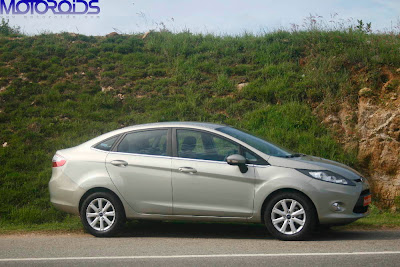 Toyota Kirloskar has officially launched the Etios Liva in India, at a staggering base price of Rs. 3.99 ex-Delhi. The car, as we told you earlier, is available in five variants. The variants, and their respective pricing is listed below.
Toyota Kirloskar has officially launched the Etios Liva in India, at a staggering base price of Rs. 3.99 ex-Delhi. The car, as we told you earlier, is available in five variants. The variants, and their respective pricing is listed below. - J: 3.99 lakh
- G: 4.59 lakh
- G SE: 5.05 lakh
- V: 5.49 lakh
- VX: 5.99 lakh
The base variant, although priced very aggressively is devoid of features.
- Engine: 1197cc naturally aspirated, inline four engine
- Power: 80PS @ 5600 rpm
- Torque: 10.6 kgm @ 3100 rpm
- 3 years 100,000 kilometers conditional warranty
- Transmission: 5-speed manual
- Best in class ARAI certified fuel efficiency of 18.31kmpl
- Best in class head, knee and leg room
- Audio system with Aux-in and USB jacks
- Engine tuned for city driving, and better efficiency than outright performance
- Twin front airbags and ABS available in the top variants
- Liva meant for primarily the young, who want to achieve
- Tagline for the Liva – Live tomorrow, Today! (in SMS slang – something that best represents today’s youth)
- Rust protection, anti-chip paint and protection under the belly
Etios Liva available in 7 colours - Large glove box with 13.0 liter capacity, can hold upto nine 500 ml water bottles and is a/c cooled.
- 7 one-liter water bottle holders in the cabin
- Plenty of other cubbyholes for knick-knacks
- Variants : J, G, V , VX – just like the Etios sedan, with VX being the top of the line variant and J being the lowest spec
- Kerb weight of 920kg makes it one of the lightest cars around. Class leading 85.8bhp/tonne power to weight ratio. Base variant only 890 kg.
- Engine a derivative of the 1.5-liter Etios sedan power plant. Essentially employs a shorter stroke. As a characteristic property of short stroke engines, the low end driveability shouldn’t be too great
- Top variants get some really neat visual add-ons such as chin spoiler, side skirts and roof spoiler
- Styling remains true to its sedan sibling to the tee
- Liberal shoulder and leg space at the back seat
- 251 liters of boot space
- Rear seat foldable, but not split
- Steering mounted audio controls on the top of the line VX variant
- Good ground clearance of 170mm
- Fuel Tank : 45 liters
- The ride quality of the car is said to be acceptable
- Official launch on the 27th of July, along with disclosure of prices
Check out the brochure image below for more details on variants and their respective features. Click Twice to see the image in full
Etios Liva Colours, Trims and Dimensions

Official Toyota Etios Liva Press Release
Toyota Kirloskar Motor Launches its first ever hatchback in India for India – Etios Liva
Youthful and sporty design, best-in-class cabin space & fuel efficiency, superior ride comfort and the legendary Toyota QDR standard
· Hiroji Onishi , President TMAP launches the Etios Liva
· Toyota forays into the popular hatchback segment
· Price starts at 3.99 Lakhs ex showroom Delhi
· Booking and deliveries start today
June 27, 2011, Delhi: Toyota Kirloskar Motor (TKM) today announced its entry into the popular hatchback segment in India, with the launch of Etios Liva. Etios sedan and the hatchback Etios Liva – built on the same platform – have been specifically developed for the Indian customers. Etios Liva inherits its name from its sedan, Etios. The word Liva has been coined from the dynamic and positive terms – Lively and Live life to the fullest – which reflect the spirit and image of the car. It is targeted at today’s youth whose spirit and belief is translated into the advertising line for Etios Liva -“LIV TMRRW 2DAY”.
Tagged – ‘Q Class Hatch’ – Etios Liva is stylishly designed and portrays a youthful and sporty image. Etios Liva will carry forward the ‘Q’ Class experience from Etios and will offer Toyota’s legendary QDR standard – Quality, Durability and Reliability at an affordable price.
Etios Liva will be available in four variants, J, G, V and VX, competitively priced between 3.99 Lakhs and 5.99 Lakhs ex-showroom Delhi. The product highlights include youthful and sporty design, best-in-class cabin space, superior ride comfort and best-in-class fuel efficiency.
Etios Liva was launched by Mr. Hiroji Onishi, (President, Toyota Motor Asia Pacific, Marketing and Sales) in the presence of Mr. Vikram Kirloskar (Vice Chairman, TKM), Mr. Hiroshi Nakagawa (Managing Director, TKM), Mr. Sandeep Singh (Deputy Managing Director-Marketing, TKM) and Mr. Yoshinori Noritake, (Chief Engineer of the Etios and Etios Liva, Toyota Motor Corporation).
Commenting on the launch of the Etios Liva, Mr. Hiroji Onishi, President, TMAP, Marketing and Sales said: “India is an integral part of our global growth strategy. The Etios project is a milestone not only for Toyota in India but for Toyota globally. The Etios Liva has been designed focusing on the Indian customer’s aspirations, tastes and preferences that were gathered, studied and understood through extensive research. We are delighted by the overwhelming response received by the Etios customers. The Etios has been well accepted by our customers. We hope the Etios Liva will further reinforce the Toyota brand in India, making Toyota a household name.”
Mr. Vikram Kirloskar, Vice Chairman, TKM, said “The Etios project is the first of its kind not for TKM alone, but also for Toyota across the globe. The key to this project, is to make TKM self sufficient by increasing the level of localization. As announced earlier, we plan to locally produce engines and transmissions at Toyota Kirloskar Auto Parts, in the third quarter of 2012. This will help us increase the local parts content in the Etios and further contribute to the social and economic growth, by enhancing self sufficiency, generating employment and expanding operations in India. Localization will further help us develop our suppliers and facilitate them to meet global standards of production. It will also generate employment and provide opportunity for expansion and growth, further strengthening our supplier base in India.”
Speaking on the occasion, Mr. Hiroshi Nakagawa, MD, TKM, said “I would like to take this opportunity to thank all our Etios customers. After the good response received by the Etios, we further expanded our production in order to cater to the huge demand. The annual production capacity will be increased to 2,10,000 units by the second quarter of 2012.
In line with our ‘customer first philosophy’, we wish to keep our customers happy and satisfied by understanding the customer’s preferences and enhancing the product by incorporating their feedback. With the Etios Liva we have now entered the mass volume segment. Toyota vehicles are now available to all aspirational buyers in the middle income group.
At Toyota, we truly believe in growing with the society. We wish to sell many more vehicles and contribute to the growth of the Indian automobile industry. Entering into the mass volume segment will help us realize this aim.”
Mr. Yoshinori Noritake, Chief Engineer of Etios and Etios Liva said “With the Etios Liva, we aspire to offer the best suited car for the Indian customer at an affordable price, while providing a vehicle that is “one class above”. After interviewing and studying the customer preferences in India, we found, the need for affordably priced, quality cars was constantly growing. We first observed various aspects that were sought after by the customer and then enhanced the features and performance aspects that were truly needed while doing away with the excessive design elements.
The stylish, sporty and trendy Etios Liva has been designed to appeal to today’s youth. We have also added style by offering aero kits with front, rear and side skirt that is sure to make heads turn. The sporty steering wheel, instrument panel -designed to give a aircraft cockpit image, a premium audio system, audio system with Aux in, USB and a wireless remote adds on to the fun, youthful and sporty image of the car.”
Talking about the Etios Sales and Marketing strategy in India, Sandeep Singh, DMD-Marketing, TKM, said “ The marketing campaign for the Etios Liva is exciting, innovative and abreast with the latest marketing tools, digital initiatives and promotions. Promotional activities targeting the youth have been planned in the popular youth hangouts like malls, pubs and also in colleges. Music maestro A R Rahman, the Brand Ambassador for Etios and Etios Liva has composed a special tune for Etios Liva ad campaign. He will also feature in a trendy music video. The music composed by Rahman, captures the spirit of today’s youth and the sporty image of Etios Liva – “Bari Hamari Hai” (Its our turn now). Watch out for Rahman’s Etios Liva tune in the TV commercial and the music video on your television screens starting today. It is also available on our website www.toyotaetiosliva.in and www.toyotabharat.com.
We have more than 20,000 happy Etios customers across the nation. Etios has been received well and appreciated by our customers. The sale for Etios was overwhelming, as we sold more than we actually planned. We have brought down the waiting period to less than a month by increasing the production. We look forward to serving more and more customers with Etios Liva and hope that we continue to delight our customers with the Q Class experience. Etios Liva will go on sale and is on display at all our dealerships starting today. We currently have 158 dealerships and will expand our dealer network to 175 by the end of this year. We aim to come closer to our customers and help them avail the best of Toyota’s “Q” Class Service. ”
Vehicle Outline
Exterior
Etios Liva is designed around the concept of ‘Bold Simplicity’. A cutting-edge and leading design that aims for a body frame and stance that stands out in a crowd. A distinctive front grille with a smile line, sculpted surface and dynamic character-line in the front and rear, enhance the presence of the Etios
Liva. The aero kit – with front and rear bumper skirt, side skirt and roof spoiler. The roof has a unique design for better aerodynamics and clean appearance.
Interior
The two toned ergonomically designed interiors are comfortable and sporty. The area surrounding the driver’s seat is given the image of a cockpit by separating the operating zone from the display zone. Large centre meter panel, that provides excellent visibility and easy to read dials. The interiors are simple yet functional, giving a high sense of quality.
The Etios Liva has best-in-class cabin space, large boot space with 251L capacity, a spacious 13L cooled glove box, seven one litre bottle holders, mobile holder and many more such useful storage spaces inside the car.
Performance and Comfort
A newly developed 1.2L, 16V DOHC engine coupled with a 5-Speed manual transmission that produces high output for superior driving performance. The torque is available at low rpm for less gear shifting and stress-free city driving.
The Etios has a best-in-class mileage of 18.31kmpl as certified by testing agency.
Electric power steering for excellent maneuverability and tilt steering ensures a good ergonomic driving experience. The steering comes with audio controls for comfort at the driver’s fingertips.
The flat type rear floor design offers ease of movement for rear seat passengers. With its rigid body structure and world class Mac Pherson Strut, the Etios has superior dampening performance providing superior ride comfort.
A class-first ‘clean air filter’ which is standard across all grades for purified air in the cabin.
Safety
The Etios has various active and passive safety features like (i) Energy absorbing body shell (ii) Driver & Passenger Air bags and (iii) ABS with EBD and (iv) Seatbelts
It’s centrally located combimeter reduces eye movement and hence the driver can concentrate on the road.
Special Treatment
· To adopt to the various diverse climate and usage conditions in India, special treatment and countermeasures have been implemented:
· Good ground clearance of 170mm
· Under body protection to prevent damage to fuel and brake lines
· Anti-corrosion steel sheets at areas prone to rusting and stone hits
· Chipping resistant paint on rocker mould & fender























































